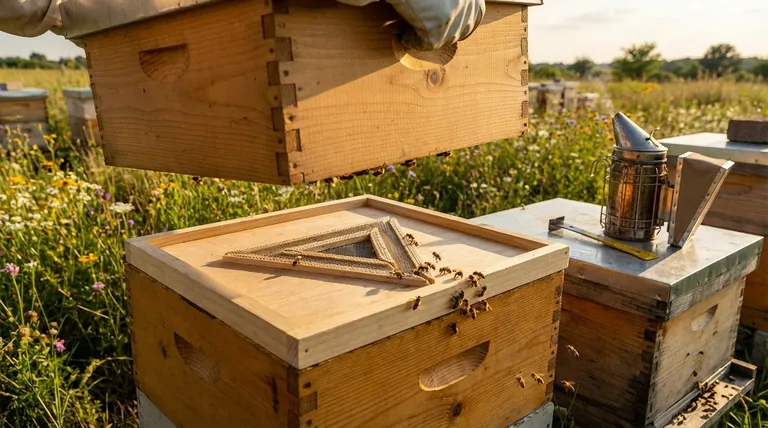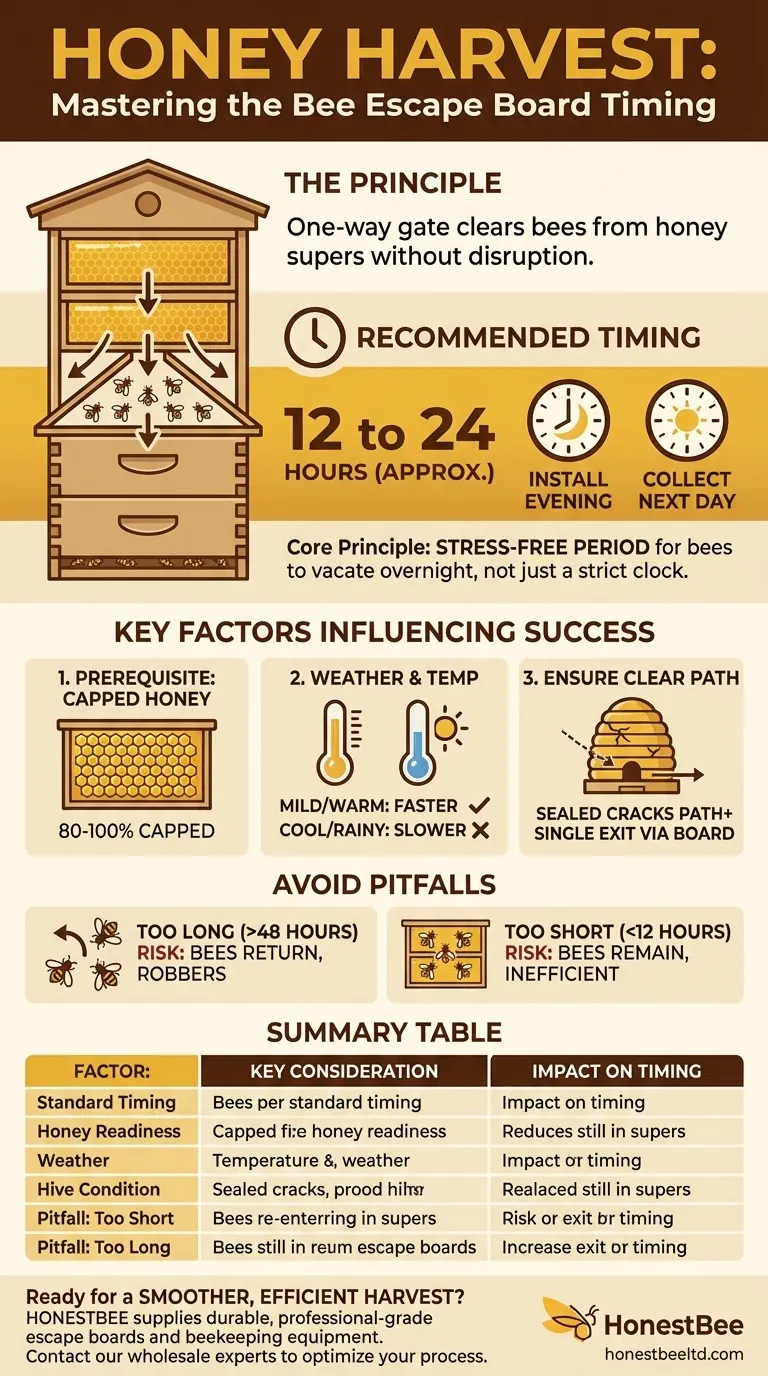The standard recommendation is to leave a triangle escape board installed on your hive for approximately 12 to 24 hours. This typically means placing it in the evening and returning the following afternoon or evening to collect the nearly bee-free honey supers.
The core principle is not about strictly following the clock, but about giving the bees a stress-free period, usually overnight, to vacate the honey supers through the one-way exit. The success of this process depends as much on hive conditions as it does on the duration.

The Principle Behind the Bee Escape Board
A bee escape board is a simple but ingenious tool designed to clear bees from honey supers with minimal disruption to the colony. Understanding its function is key to using it effectively.
How It Works
The board acts as a one-way gate. It is placed between the honey supers you intend to harvest and the brood boxes below. Bees in the supers can travel down through the escape's funnel or triangle-shaped exits to rejoin the main cluster, but they cannot find their way back up.
Why Timing is Critical
The 12-to-24-hour window is a functional guideline. It allows sufficient time for the worker bees in the upper boxes to sense their separation from the queen and colony, find the exits, and move down. Placing it in the evening is particularly effective as bees naturally coalesce into the main cluster overnight.
Key Factors That Influence Success
Simply setting a timer isn't enough. Several environmental and hive-specific factors can alter how quickly your supers are cleared.
Prerequisite: Capped Honey
Before you even consider using an escape board, ensure the honey is ready. Frames should be at least 80-100% capped. Capping indicates the bees have reduced the honey's water content to below 18%, making it stable for storage. Trying to clear bees from uncapped nectar is premature.
Weather and Temperature
Bees are less active in cool or rainy weather. If temperatures are low, they may cluster for warmth within the honey super and be reluctant to move, slowing down the clearing process significantly. Ideal conditions are mild to warm.
Ensuring a Clear Path
The escape board must be the only way out. Before installation, check your honey supers for any cracks, holes, or upper entrances that bees could use. Seal any alternate routes to ensure they are funneled through the escape.
Understanding the Trade-offs and Pitfalls
While highly effective, improper use of a bee escape board can lead to frustration. Knowing the potential downsides helps you avoid them.
Leaving It On Too Long
If you wait longer than 24-48 hours, some clever bees may figure out how to get back into the supers. More importantly, it can create congestion in the brood boxes and, if the board isn't sealed perfectly, may even attract robber bees from other hives.
Not Leaving It On Long Enough
Removing the board too early, especially after less than 12 hours, will result in a job half-done. You will arrive to find a significant number of bees still in the supers, defeating the purpose of the tool and forcing you to resort to brushing or blowing them out.
Making the Right Choice for Your Harvest
Use the 24-hour rule as your baseline, but adjust based on your specific conditions to ensure a smooth and successful harvest.
- If your primary focus is a standard harvest with a healthy hive and good weather: Installing the board in the evening and returning the next afternoon (around 20-24 hours) is a reliable strategy.
- If your primary focus is harvesting during cooler weather or from an exceptionally large colony: Plan for the full 24 hours and check a corner of the super before removing it entirely to ensure it is clear.
- If you must verify the honey is ready first: Only install the escape board after you have confirmed the frames are sufficiently capped and ready for extraction.
Properly timing your bee escape board transforms the honey harvest from a potentially chaotic task into a calm and efficient process.
Summary Table:
| Factor | Key Consideration | Impact on Timing |
|---|---|---|
| Standard Timing | Install in evening, harvest next afternoon. | 12-24 hours (baseline). |
| Honey Readiness | Frames must be 80-100% capped. | Install board only after this is confirmed. |
| Weather | Mild/warm weather is ideal; cool/rainy slows bees. | May require the full 24 hours or more. |
| Hive Condition | Ensure the escape board is the only exit; seal cracks. | Prevents bees from staying in the supers. |
| Pitfall: Too Short | Removing board too early. | Bees remain in supers; harvest is inefficient. |
| Pitfall: Too Long | Leaving board for >48 hours. | Risk of bees returning or attracting robbers. |
Ready for a smoother, more efficient honey harvest?
As a commercial beekeeper or distributor, your time and the health of your colonies are paramount. HONESTBEE supplies the durable, well-designed beekeeping equipment—including reliable escape boards—that professionals depend on for a stress-free operation.
Let us help you optimize your harvest process. Contact our wholesale experts today to discuss your equipment needs and discover how we can support your business's success.
Visual Guide

Related Products
- HONESTBEE Wooden Bee Escape Board with Triangle Mesh Design for Beekeeping
- HONESTBEE Multi Exit Plastic Bee Escape Board for Efficient Honey Harvesting
- HONESTBEE 4-Way Metal Corner Wooden Bee Escape Board
- Durable 16 Way Circular Bee Escape for Efficient Honey Harvesting
- Circular Labyrinth Bee Escape for Efficient Hive Management
People Also Ask
- What are the available frame sizes for Triangular Escape Boards? Find the Perfect Fit for Your Hive
- How is the Triangle Bee Escape Board placed when removing a super? Master the Correct Placement for a Stress-Free Harvest
- What precautions should be taken when using the triangle escape board? Master Gentle Honey Harvesting
- What precautions should be taken when using the triangle bee escape board? Ensure a Gentle & Successful Honey Harvest
- What are the recommended conditions for using the triangle bee escape board? Ensure a Successful, Low-Stress Honey Harvest



















